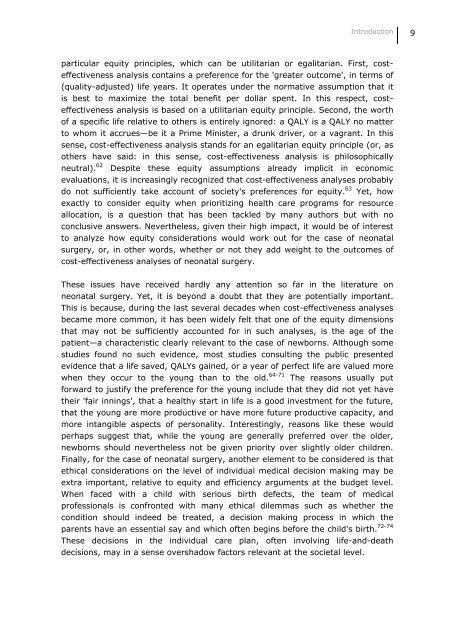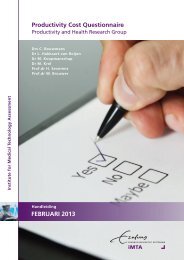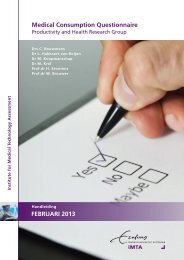Marten J. Poley - Erasmus Universiteit Rotterdam
Marten J. Poley - Erasmus Universiteit Rotterdam
Marten J. Poley - Erasmus Universiteit Rotterdam
- No tags were found...
Create successful ePaper yourself
Turn your PDF publications into a flip-book with our unique Google optimized e-Paper software.
Introduction 9particular equity principles, which can be utilitarian or egalitarian. First, costeffectivenessanalysis contains a preference for the 'greater outcome', in terms of(quality-adjusted) life years. It operates under the normative assumption that itis best to maximize the total benefit per dollar spent. In this respect, costeffectivenessanalysis is based on a utilitarian equity principle. Second, the worthof a specific life relative to others is entirely ignored: a QALY is a QALY no matterto whom it accrues—be it a Prime Minister, a drunk driver, or a vagrant. In thissense, cost-effectiveness analysis stands for an egalitarian equity principle (or, asothers have said: in this sense, cost-effectiveness analysis is philosophicallyneutral). 62 Despite these equity assumptions already implicit in economicevaluations, it is increasingly recognized that cost-effectiveness analyses probablydo not sufficiently take account of society's preferences for equity. 63 Yet, howexactly to consider equity when prioritizing health care programs for resourceallocation, is a question that has been tackled by many authors but with noconclusive answers. Nevertheless, given their high impact, it would be of interestto analyze how equity considerations would work out for the case of neonatalsurgery, or, in other words, whether or not they add weight to the outcomes ofcost-effectiveness analyses of neonatal surgery.These issues have received hardly any attention so far in the literature onneonatal surgery. Yet, it is beyond a doubt that they are potentially important.This is because, during the last several decades when cost-effectiveness analysesbecame more common, it has been widely felt that one of the equity dimensionsthat may not be sufficiently accounted for in such analyses, is the age of thepatient—a characteristic clearly relevant to the case of newborns. Although somestudies found no such evidence, most studies consulting the public presentedevidence that a life saved, QALYs gained, or a year of perfect life are valued morewhen they occur to the young than to the old. 64-71 The reasons usually putforward to justify the preference for the young include that they did not yet havetheir 'fair innings', that a healthy start in life is a good investment for the future,that the young are more productive or have more future productive capacity, andmore intangible aspects of personality. Interestingly, reasons like these wouldperhaps suggest that, while the young are generally preferred over the older,newborns should nevertheless not be given priority over slightly older children.Finally, for the case of neonatal surgery, another element to be considered is thatethical considerations on the level of individual medical decision making may beextra important, relative to equity and efficiency arguments at the budget level.When faced with a child with serious birth defects, the team of medicalprofessionals is confronted with many ethical dilemmas such as whether thecondition should indeed be treated, a decision making process in which theparents have an essential say and which often begins before the child's birth. 72-74These decisions in the individual care plan, often involving life-and-deathdecisions, may in a sense overshadow factors relevant at the societal level.
















